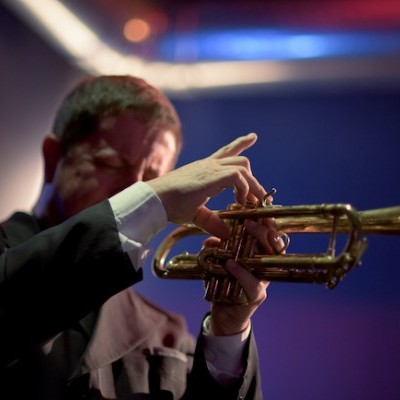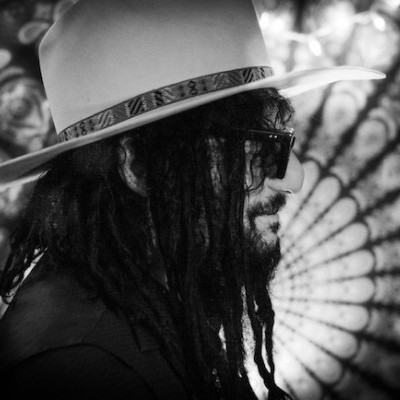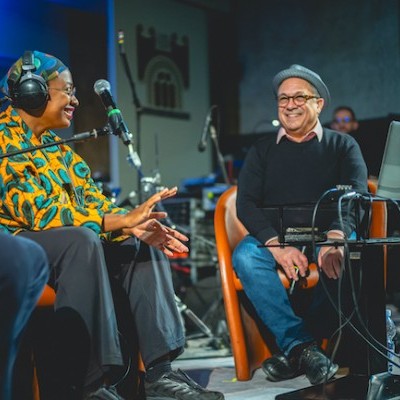Jul 9, 2024 11:35 AM
Trumpeter, Educator Jim Rotondi Dies at 61
Jim Rotondi, a renowned hard-bop trumpeter, composer and educator, died suddenly on July 7 at a hospital in France. He…
When bassist Anna Butterss moved to Los Angeles in 2014, her plan was to stay for no more than a year. Her main draw to the city was her boyfriend, saxophonist Josh Johnson, who had arrived a couple of years before her to study at the Thelonious Monk Institute of Jazz at UCLA. Beyond that, she had “no expectations coming in,” she said. “It wasn’t a place I’d ever really thought about living.”
Four years later, the Australian native is thriving in her new home. “It just turned out to be surprisingly fantastic,” she said. “I’m working more than I ever worked in my life and I think probably more than I would have if I’d been in New York.”
Butterss’ experience is emblematic of how much the L.A. jazz scene has grown in recent years, attracting musicians from around the world to complement its homegrown talent. The rapturous international response to saxophonist Kamasi Washington’s 2015 album The Epic was an obvious turning point. But even before that, there was a surge of excitement around jazz in the city, spurred on by a confluence of factors: the now-legendary gigs by Washington’s group, the West Coast Get Down, at the Piano Bar in Hollywood; the launch of the Angel City Jazz Festival in 2008 and the Bluewhale jazz club in 2009, both of which immediately stood out for their adventurous programming; the arrival of several high-profile transplants, including guitarist Jeff Parker and saxophonists Steve Lehman and Chris Speed; and the 2012 return of the Thelonious Monk Institute of Jazz, after a four-year stint in New Orleans (previously, it had resided at USC’s Thornton School of Music; beginning in 2019 the organization announced it will be called the Herbie Hancock Institute of Jazz).
L.A. has a long history as a jazz epicenter, dating back to clubs that thrived along Central Avenue from the Prohibition-era through the bebop era, where Eric Dolphy, Charles Mingus, Art Tatum and Ornette Coleman paid their dues. The city also fostered Gerry Mulligan and Chet Baker’s development of cool jazz, and more recently was home to a big band revival, populated by the city’s vast pool of seasoned studio players, and spearheaded by Gordon Goodwin’s Big Phat Band and John Beasley’s MONK’estra. But the recent surge in young talent is something the city hasn’t seen in decades.
“There’s a lot to do here and it seems like it’s only expanding,” said Johnson, who performs with Butterss most Monday nights at ETA, an intimate cocktail bar in L.A.’s trendy Highland Park neighborhood, in a quartet led by Parker. “It’s an interesting mix of people [who are] playing at a high level.”
Across the street from ETA last summer, that mix was on full display at the Lodge Room, a one-year-old music venue that played host to a performance by drummer/keyboardist Louis Cole. His latest release, Time, might not exactly be a jazz album; though the recording features guest appearances by bassist Thundercat and pianist Brad Mehldau, it owes more to the ’80s pop-funk of Prince and the Gap Band. But his album-release performance played out like a stealth jazz concert. After a spacey synthesizer intro, a curtain covering half the stage dropped to reveal a 12-piece horn section, featuring a who’s who of young L.A. players, including Johnson, Kneebody’s Ben Wendel, and Amber Navran and Andris Mattson of soul-jazz trio Moonchild.
After the show, Cole explained the somewhat thrown-together nature of his large ensemble, which he assembled as a one-off with “a massive amount of text messages” and fewer scheduling headaches than one might expect. “You’d think it would actually be harder,” he said. “But for that particular show, it was kind of easy. All those guys are my friends. ... Everyone just said, ‘yes,’ and it was just done.”
Cole’s show spoke both to the close-knit nature of L.A.’s young jazz community and its depth of talent. When their turns came to solo, even his ensemble’s unheralded players delivered wildly creative improvisations to match Cole’s exuberant compositions. After one particularly acrobatic barrage by Vikram Devasthali, an audience member exclaimed, “He just weaponized the trombone.”
In addition to Devasthali and Cole, several other Thornton School graduates performed alongside recent grads from the Monk Institute and CalArts. L.A. long has been home to many of the nation’s top music schools, but until recently, few students stayed in town after graduation. That’s starting to change, said Monk Institute West Coast Director Daniel Seeff. “There were four [Monk Institute] classes at USC from ’99 to 2007 and almost all of them would just move right away to New York. And now it’s about 50-50; half of them go to New York and the other half stay here.”
In the case of Johnson’s Monk Institute class, which graduated in 2014, the entire group not only remained in Los Angeles, but continues to work together under the name Holophonor. The group’s Wayne Shorter-produced album, Light Magnet, arrived in 2017 to widespread acclaim. It was released on World Galaxy, an upstart jazz-adjacent label founded by Kevin “Daddy Kev” Moo, better known to L.A.’s experimental electronic music scene through his other imprint, Alpha Pup, and his recently concluded club night, Low End Theory. Recognizing that many young L.A. jazz artists still were going unheard, Moo founded World Galaxy to give their records a home—and improve those records’ chances of reaching his existing audience, an assortment of listeners primed by The Epic and rapper Kendrick Lamar’s jazz-informed To Pimp A Butterfly.
“You have a new generation of kids that’s grown up listening to Thundercat and Kendrick Lamar,” Moo said. “This is informing an entire generation’s understanding of what jazz music can be.”

Jim Rotondi was acclaimed for his wide, round trumpet tone, remarkable virtuosity and assured swing.
Jul 9, 2024 11:35 AM
Jim Rotondi, a renowned hard-bop trumpeter, composer and educator, died suddenly on July 7 at a hospital in France. He…

Charles Lloyd, seen here at the 2024 New Orleans Jazz & Heritage Festival, makes DownBeat Poll history!
Jul 11, 2024 12:23 PM
The incomparable Charles Lloyd swept the 72nd Annual DownBeat Critics Poll, becoming the first artist ever to earn…

“Being president of Blue Note has been one of the coolest things that ever happened to me,” Was said. “It’s a gas to serve as one of the caretakers of that legacy.”
Jun 4, 2024 12:21 PM
Sitting with Don Was is a comfortable and unhurried exercise. He may seem slightly reserved at first, but ideas and…

“She reminds me of my childhood and makes we want to cry,” Cécile McLorin Salvant, pictured here with writer Ashley Kahn, said of Dianne Reeves.
Jun 11, 2024 12:31 PM
Italy’s Umbria Jazz Winter is one of those rare annual festivals that not only coincides with a major holiday —…

Maria Schneider said of Decades, her new compilation release: “I just wanted to create something, put it in a beautiful box and say, ‘Look at what we did.‘”
Jun 18, 2024 12:00 PM
Maria Schneider opened the sleek black box and placed it on a coffee table in her Manhattan apartment. Inside lay the…